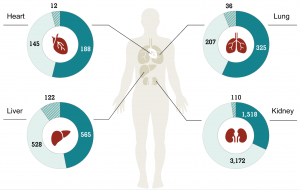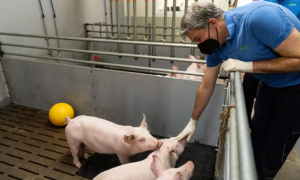If due to an unfortunate accident, you were on the National Organ Waitlist for a heart transplant, would you consider receiving a heart from an animal?
Since the first organ transplant, there has been a shortage of healthy organ donors all around the world. For example, last year in Canada, about 280 people died while waiting for an organ transplant. This shortage is much greater in more populated countries such as the US, where on average ten people lose their lives every day. To resolve this shortage, doctors have tried to transplant animal blood and organs to humans. Unfortunately, they have not been very successful until recently, due to the complexity of the human body and the anatomic variations between different species. However, using genetic engineering, scientists have been able to transplant a few animal organs to humans, including the first pig heart!
Human Body & Organ Transplant
The human body is like a very complex machine, with microscopic vessels and delicate tissues. A slight change or injury to an organ can be disastrous. When a vital organ, such as the heart is damaged beyond recovery, doctors have to replace it with a donor’s organ, which is usually a deceased person.
Organ transplant has saved countless lives over the decades but it can commonly result in complications, especially if there is low blood type compatibility between the recipient and the donor. If the recipient’s blood type does not match the donor’s blood type, the recipient’s body will reject the organ. During organ rejection, the transplanted organ is nothing more than a foreign object to the body, like bacteria. The body’s defense mechanisms will try to remove the transplanted which usually results in death.

Dark green represents the number of transplants, light green represents the number of patients on waitings lists and the dashes green represents the number of dead patients while waiting for a transplant. Image by Canadian Organ Replacement Register https://www.cihi.ca/en/organ-transplants-in-canada-2020-donations-and-need-infographic
Genetically Modified Pig Heart Transplant
However, on January 7th, 2022, scientists and doctors made a huge advancement in this field. They were able to transplant the first-ever genetically modified pig heart into a 57-year-old man, who was suffering from life-threatening heart disease. David Bennett has been recovering from the operation and is currently healthy and stable.
Why use a genetically modified pig heart?
There are many reasons why scientists used a pig as the donor, mainly because pigs are very anatomically similar to humans. In both adulthood and childhood, their organs are similar in size and function to humans, making them well suited for transplant. Additionally, pigs reproduce at a fast pace and can be bred at high health standards in labs. There are labs in the world that breed and clone pigs for organ transplants.

Eckhard Wolf with pigs in at the Badersfeld bog test farm in Oberschleissheim, Germany. Photographed by Lukas Barth/Reuters https://www.theguardian.com/science/2022/feb/03/german-researchers-to-breed-pigs-for-human-heart-transplants
Using advanced technology, scientists were able to edit parts of the DNA of a pig and turned off genes (the building blocks of DNA) that resulted in organ rejection. This eliminated the need to find a compatible blood type donor.
In Conclusion:
The use of animal organs for transplant is not a simple matter, since there is still a lot of controversy around the topic. Many believe that genetic engineering is a technology that humans should not explore. Others bring up the issue of animal welfare and question the practice entirely. However, if more research is completed on genetically modifying animals for organ transplants, we might be able to solve the organ donor shortage entirely. Patients will not have to wait on long lists to receive organs to live and we could minimize the risks of organ transplants significantly, saving thousands if not millions of lives.
By Shayan Abbaszadeh

One response to “First Genetically Modified Pig Heart Transplant”